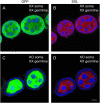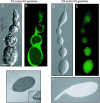Drosophila melanogaster male somatic cells feminized solely by TraF can collaborate with female germ cells to make functional eggs
- PMID: 17110478
- PMCID: PMC1800625
- DOI: 10.1534/genetics.106.066332
Drosophila melanogaster male somatic cells feminized solely by TraF can collaborate with female germ cells to make functional eggs
Abstract
Female differentiation of Drosophila germ cells is induced by cell-nonautonomous signals generated in the gonadal soma that work with germ-cell-autonomous signals determined by germ-cell X chromosome dose. Generation of the nonautonomous feminizing signals was known to involve female-specific protein encoded by the master sex-determination gene Sex-lethal (Sxl) acting on its switch-gene target transformer (tra) to produce Tra(F) protein. However, it was not known whether Sxl's action on tra alone would suffice to trigger a fully feminizing nonautonomous signal. We developed a constitutively feminizing tra transgene that allowed us to answer this question. In gynanders (XX//XO mosaics) feminized by this Tra(F) transgene, functionally Sxl- haplo-X (chromosomally male) somatic cells collaborated successfully with diplo-X (chromosomally female) germ cells to make functional eggs. The fertility of such gynanders shows not only that Tra(F) is sufficient to elicit a fully feminizing nonautonomous signal, but also that haplo-X somatic cells can execute all other somatic functions required for oogenesis, despite the fact that their genome is not expected to be dosage compensated for such diplo-X-specific functions. The unexpected observation that some Tra(F)-feminized gynanders failed to lay their eggs showed there to be diplo-X cells outside the gonad for which Tra(F)-feminized haplo-X cells cannot substitute.
Figures



Similar articles
-
Drosophila switch gene Sex-lethal can bypass its switch-gene target transformer to regulate aspects of female behavior.Proc Natl Acad Sci U S A. 2013 Nov 19;110(47):E4474-81. doi: 10.1073/pnas.1319063110. Epub 2013 Nov 4. Proc Natl Acad Sci U S A. 2013. PMID: 24191002 Free PMC article.
-
Sexual back talk with evolutionary implications: stimulation of the Drosophila sex-determination gene sex-lethal by its target transformer.Genetics. 2008 Dec;180(4):1963-81. doi: 10.1534/genetics.108.093898. Epub 2008 Oct 9. Genetics. 2008. PMID: 18845845 Free PMC article.
-
Sxl in the germline of Drosophila: a target for somatic late induction.Dev Genet. 1994;15(3):265-74. doi: 10.1002/dvg.1020150308. Dev Genet. 1994. PMID: 8062458
-
Genetic control of germline sexual dimorphism in Drosophila.Int Rev Cytol. 2002;219:1-60. doi: 10.1016/s0074-7696(02)19010-3. Int Rev Cytol. 2002. PMID: 12211627 Review.
-
Sex determination of germ cells in Drosophila.Ciba Found Symp. 1994;182:193-202; discussion 202-9. doi: 10.1002/9780470514573.ch11. Ciba Found Symp. 1994. PMID: 7835150 Review.
Cited by
-
Phf7 controls male sex determination in the Drosophila germline.Dev Cell. 2012 May 15;22(5):1041-51. doi: 10.1016/j.devcel.2012.04.013. Dev Cell. 2012. PMID: 22595675 Free PMC article.
-
Drosophila switch gene Sex-lethal can bypass its switch-gene target transformer to regulate aspects of female behavior.Proc Natl Acad Sci U S A. 2013 Nov 19;110(47):E4474-81. doi: 10.1073/pnas.1319063110. Epub 2013 Nov 4. Proc Natl Acad Sci U S A. 2013. PMID: 24191002 Free PMC article.
-
Sexual back talk with evolutionary implications: stimulation of the Drosophila sex-determination gene sex-lethal by its target transformer.Genetics. 2008 Dec;180(4):1963-81. doi: 10.1534/genetics.108.093898. Epub 2008 Oct 9. Genetics. 2008. PMID: 18845845 Free PMC article.
-
Sex determination gene transformer regulates the male-female difference in Drosophila fat storage via the adipokinetic hormone pathway.Elife. 2021 Oct 21;10:e72350. doi: 10.7554/eLife.72350. Elife. 2021. PMID: 34672260 Free PMC article.
-
Drosophila germline sex determination: integration of germline autonomous cues and somatic signals.Curr Top Dev Biol. 2008;83:109-50. doi: 10.1016/S0070-2153(08)00404-3. Curr Top Dev Biol. 2008. PMID: 19118665 Free PMC article.
References
-
- Arthur, B. I., Jr., J. M. Jallon, B. Caflisch, Y. Choffat and R. Nothiger, 1998. Sexual behaviour in Drosophila is irreversibly programmed during a critical period. Curr. Biol. 8: 1187–1190. - PubMed
-
- Bopp, D., J. I. Horabin, R. A. Lersch, T. W. Cline and P. Schedl, 1993. Expression of the Sex-lethal gene is controlled at multiple levels during Drosophila oogenesis. Development 118: 797–812. - PubMed
-
- Bownes, M., K. Lineruth and D. Mauchline, 1991. Egg production and fertility in Drosophila depend upon the number of yolk-protein gene copies. Mol. Gen. Genet. 228: 324–327. - PubMed
Publication types
MeSH terms
Substances
Grants and funding
LinkOut - more resources
Full Text Sources
Molecular Biology Databases

